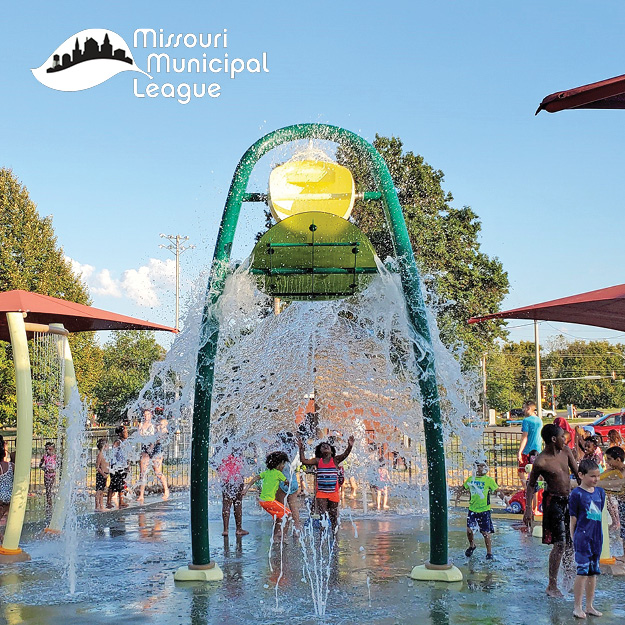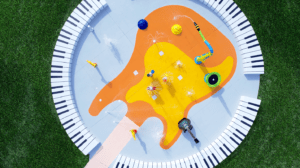Municipal Swimming Pools Versus Splash Pads

March/April 2024 | As we approached 2020, innovation in municipal aquatic facilities was advancing at a great clip. Then Covid hit and municipalities pulled back as families went into isolation. Those were dark days, but it also reinforced the value and community connectivity of well-designed municipal swimming pools and splash pads. Three years later, supply chain constrictions have eased, and families yearn to connect even more. But in the welcome return of community enrichment stifled by the pandemic, what’s best for a municipality – a swimming pool or a splash pad or combination of both? Let’s take a look.
Everything begins with a municipality’s needs and a feasibility study to meet those needs. Citizen surveys and public hearings ultimately define the need. Thoughtful budgeting and fine-tuning design and construction will ultimately shape the outcome.
Swimming pools are obviously more expensive than splash pads, both to build and maintain. It requires a full-time lifeguard staff, more pumps, filters, chemicals, support infrastructure like bath houses and concessions, specialized electrical systems, more maintenance and greater liability costs. A municipal swimming pool for a small Missouri town can generally run $3 million to $3.5 million or more to build.
The cost of a standard municipal splash pad is largely dependent on whether it is a drain-away system or requires filtration to recycle chemically treated water. Drain-away splash pads tap into the potable municipal water supply and let it drain into the sewer system. It can cost $350,000 to $500,000 to build, but it also uses enormous amounts of water. A drain-away splash pad can use 20,000 to 50,000 gallons of water a day or upwards to a million gallons from a Memorial Day opening to a Labor Day closing.
A splash pad with a filtration system requires more infrastructure – a holding tank, pumps, filtration and chemicals – and can cost $450,000 or more, depending on its size. But because the water is being treated and recirculated, it can use up to 200 gallons a day or approximately 25,000 gallons depending on backwashing needs and the frequency of draining tanks through the same three-month summer season.
When opting for a swimming pool, municipalities need to think about its functionality, an important part of any feasibility study. Some cities have the capacity to field swim teams making a lap pool a consideration. Pools are also very much “hang out” areas for people of all ages, but especially teens, with a little fun mixed in. That will dictate a number of things – a diving board, perhaps an edge-of-the-water rock climbing feature, a shallow-end bucket splash and other drenching aquatics. It may feature a zero-entry for families with small children with features found in splash pads.
Larger cities typically want a robust concession area while smaller cities tend to go with small snack bars – both concepts are designed to keep people at the pool longer. Likewise, bath houses with changing areas, showers and restrooms are standard amenities and need to be factored into planning and budgeting for pools.
A growing trend seen by Capri Pools & Aquatics is themed splash pads designed to support child development. In Sedalia, Missouri, it takes shape in a musical-themed splash pad – animated with instruments. Patrons are greeted by the neck of a guitar painted on the walkway leading to the main body of the instrument that enlivens the pad. Bench seating and surrounding wet areas of the pad are painted to look like piano keys. In Florissant, Missouri, the splash pad features some ADA elements, including an Aqua Gather station where a wheelchair can fit under an interactive splash table. It also features a pour-in-place rubber surface and an interactive Hydro Helix, an umbrella-like feature that that can be spun to create a fun helix pattern as it sheds water. The key outcome in both is children playing and engaging in the spray area and learning. They developed social skills along with tactile, balance, motor skills and play imagination, all stimulated safely on a wet surface with water cascading from an animated playground that fires the imagination. Meanwhile, parents can play with their children or engage with one another as their kids delight in a watery wonderland.

Hubbard Park Splash Pad | Sedalia, MO
All municipalities need to consider the cost of maintenance in the planning stages. Swimming pools will need to be covered and winterized. Water lines will need to be drained, plugged and protected with anti-freeze over the winter months. Pools will generally need to be painted every three to five years and plaster or quartz surfaced pools will need to be replaced every eight to 10 years. Motors and pumps, of which there are many with pools, can have a life span of three to eight years. Idle time in cold climates tends to create more wear and tear on motors. Other maintenance factors to budget are sanitizing chemicals, pool cleaning and lifeguards. A well-designed and maintained pool should have a 25- to 30-year life span.
Likewise, splash pads require winterizing and yearly maintenance that should be part of initial planning. Fortunately, other expenses such as chemicals and pump maintenance are much lower than pools. Splash pads also do not require lifeguards. Some cities opt for a broom-finished concrete surface to mitigate slipping on tiny feet. Communities also select unpainted surfaces to allow more of the budget to be devoted to other amenities by avoiding yearly repainting. Spray nozzles should be selected that can be easily unclogged and consideration should be given to play features that are easily replaceable without having to tear up the concrete. A well-designed splash pad with easy maintenance in mind should last 15 to 20 years.
Finally, with a little forethought, splash pads can have a longer season than pools – opening two weeks before a pool opens and closing two weeks after pools are shut down. Where splash pads are part of a main pool, this extended play time will require thought on fencing or some way to keep young children confined to the splash pad area and not wander off toward the dormant pool. Otherwise, a stand-alone splash pad in a park should not require fencing.
Municipalities can embrace the community enrichment value of pools and splash pads that connect their citizens through leisure and play as they cool off during hot Missouri summers. But optimal and enduring value begins with careful planning with a purpose if municipalities want to make a big splash with the community they serve.
Dave Wiecher is vice president of St. Charles-based Capri Pools & Aquatics, a division of Contegra Enterprises. With 38 years’ experience in the aquatics industry, he leads his team in designing and constructing both new and renovated aquatic centers, commercial pools, spas and splash pads. For more information, visit www.capripool.com.
Article courtesy of Missouri Municipal Review Magazine



